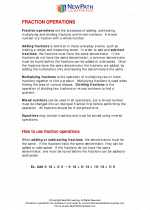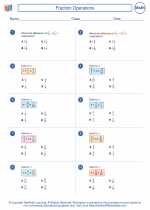Fraction Operations: Addition, Subtraction, Multiplication, and Division
Introduction to Fractions
A fraction represents a part of a whole. It consists of a numerator (the top number) and a denominator (the bottom number). Fractions are used to represent numbers that are not whole numbers, such as 1/2, 3/4, 5/8, etc.
Adding and Subtracting Fractions
When adding or subtracting fractions, the first step is to make sure the denominators are the same. If they are not, find a common denominator. Once the denominators are the same, add or subtract the numerators and keep the denominator the same.
Example:
Find the sum of 1/3 and 2/5.
First, find a common denominator, which is 15. Then, rewrite the fractions with the common denominator: 1/3 = 5/15 and 2/5 = 6/15 Now, add the fractions: 5/15 + 6/15 = 11/15 So, 1/3 + 2/5 = 11/15
Multiplying and Dividing Fractions
When multiplying fractions, simply multiply the numerators together to get the new numerator, and multiply the denominators together to get the new denominator. When dividing fractions, multiply the first fraction by the reciprocal of the second fraction.
Example:
Find the product of 2/3 and 3/4.
Multiply the numerators and denominators together: 2/3 * 3/4 = (2*3)/(3*4) = 6/12 Simplify the fraction: 6/12 = 1/2 So, 2/3 * 3/4 = 1/2
Practice Problems
- Find the sum of 3/4 and 5/6.
- Find the difference between 7/8 and 2/3.
- Find the product of 2/5 and 3/4.
- Find the quotient of 5/6 and 2/3.
Study Tips
- Practice finding common denominators for adding and subtracting fractions.
- Remember to simplify your answers whenever possible.
- When dividing fractions, multiply by the reciprocal of the second fraction.
- Use visual representations like fraction bars to help understand fraction operations.
By practicing these operations and study tips, you can improve your skills in working with fractions!
[Fraction Operations] Related Worksheets and Study Guides:
.◂Math Worksheets and Study Guides Seventh Grade. Fraction Operations

 Worksheet/Answer key
Worksheet/Answer key
 Worksheet/Answer key
Worksheet/Answer key
 Worksheet/Answer key
Worksheet/Answer key
